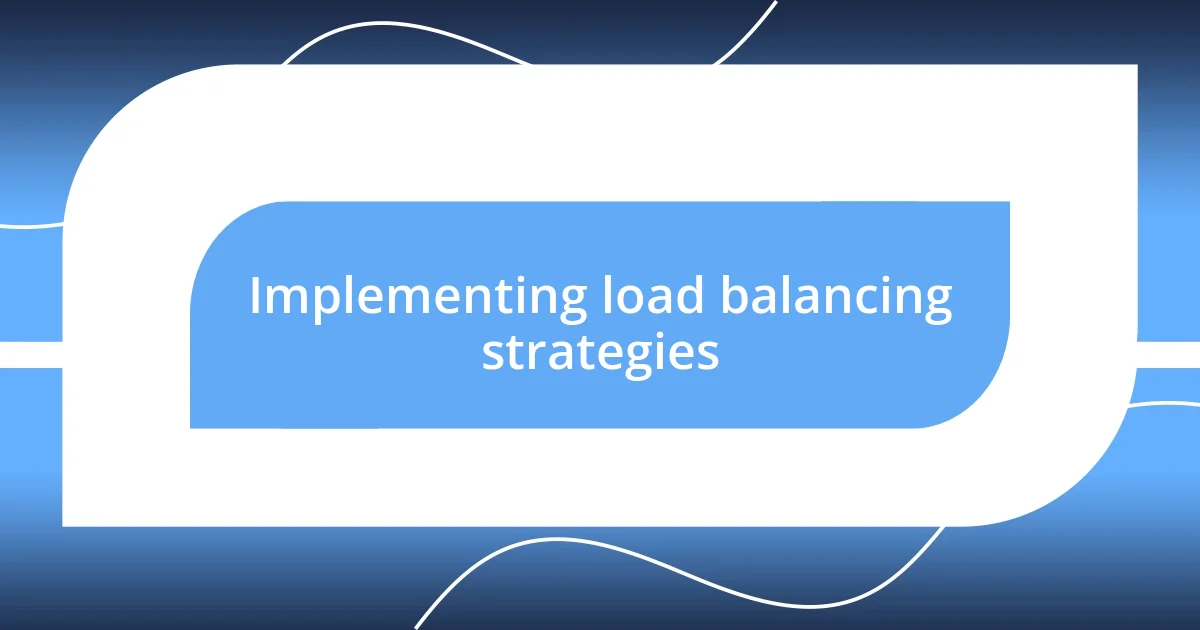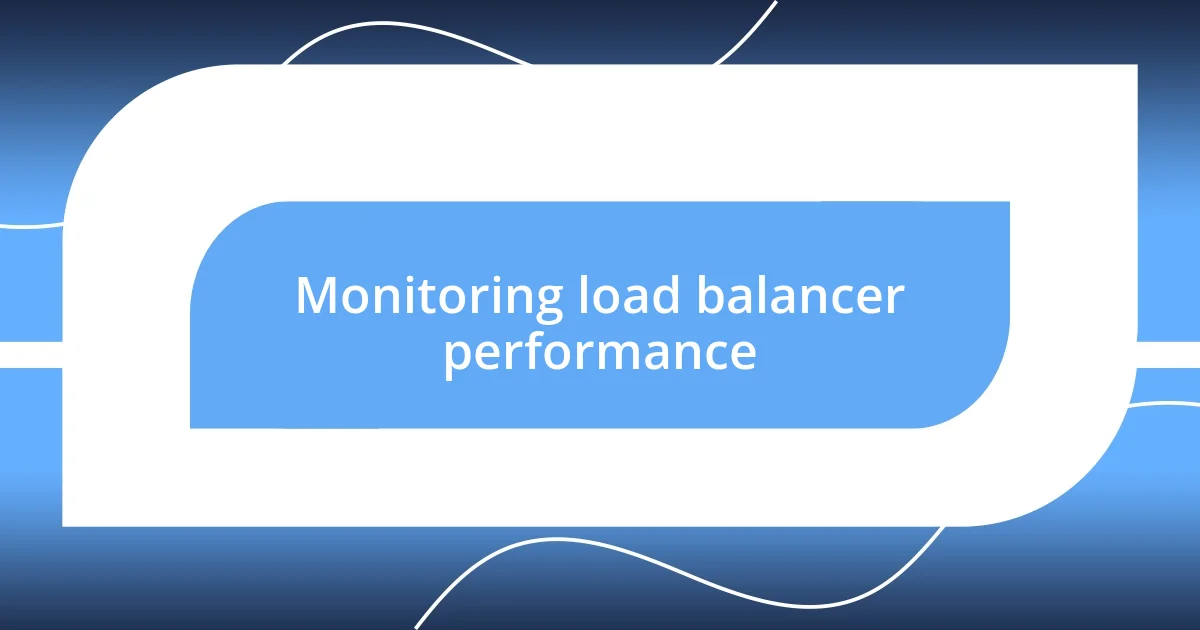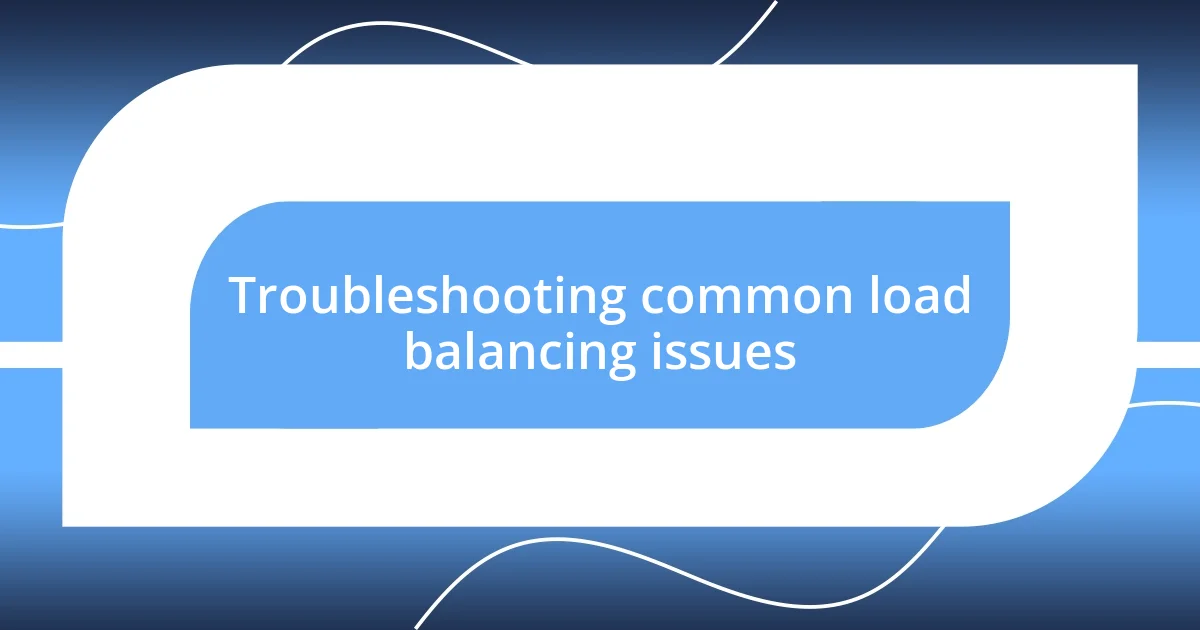Key takeaways:
- Effective load balancing is crucial for managing high traffic, utilizing strategies like dynamic and geographical load balancing to enhance performance and user experience.
- Choosing the right load balancer involves evaluating factors such as traffic type, scalability, cost, ease of configuration, and monitoring capabilities.
- Proactive monitoring and troubleshooting are essential to resolving issues like uneven traffic distribution, slow response times, and misconfigured SSL settings, which can significantly impact user experience.

Understanding load balancing concepts
Load balancing is essentially the practice of distributing network traffic across multiple servers to ensure no single server gets overwhelmed. I remember during a particularly high-traffic event, the pressure was palpable as we watched user demand spike—it’s moments like these that really demonstrate the importance of proper load balancing. Have you ever been frustrated by a slow-loading website? That’s often a direct result of inadequate load management.
When I first learned about different load balancing algorithms, it was eye-opening to see how they could influence performance. From round-robin to least connections, each method has its advantages and quirks, which can significantly impact user experience. For example, I found the least connections method quite effective during periods of fluctuating traffic, as it ensured that servers with fewer active connections would handle new requests first.
What struck me most was understanding the difference between hardware and software load balancers. The former can be quite costly and complex, while the latter offers flexibility and ease of integration. In my experience, using a software solution allowed us to scale more rapidly, adapting to our needs without the heavy financial strain. Have you ever considered how the choice between these can shape your infrastructure strategy?

Choosing the right load balancer
Choosing the right load balancer can feel overwhelming, but personal experience has taught me that the right decision can make all the difference. When I was faced with a major overhaul of our architecture, I vividly recall examining my options closely—it was like choosing the right partner for a project. A load balancer needs to align with your specific goals and infrastructure, whether that’s enhancing security, improving traffic handling, or ensuring uptime.
Here are some key factors to consider when selecting the best load balancer for your needs:
- Traffic Type: Understand the nature of your traffic; is it HTTP, TCP, or UDP? Each type may require a different handling approach.
- Scalability: I found that solutions allowing for horizontal scaling were essential. You should evaluate how easily the load balancer can grow with your needs.
- Cost: Weigh the initial cost against the benefits in performance and reliability. Sometimes, spending a bit more upfront can save you in the long run.
- Ease of Configuration: The user-friendly setup of a load balancer simplifies your workflow. I learned this when a complex configuration cost us precious time during implementation.
- Monitoring Capabilities: Effective monitoring tools are crucial for real-time insights. I remember a time when detailed analytics provided clarity on performance issues, leading to timely resolutions.
Making an informed choice can pave the way for a resilient infrastructure, and, trust me, that’s something worth investing time into.

Implementing load balancing strategies
Implementing load balancing strategies demands a thoughtful approach, as the right tactics can significantly optimize server performance. One strategy I found incredibly effective is the combination of dynamic and static load balancing. During a significant product launch, we experienced intense traffic spikes. By using dynamic balancing, which adapts in real-time to traffic patterns, alongside static rules for predictable loads, I was able to manage the incoming requests more efficiently, ensuring that user requests didn’t go unanswered.
I remember a particular situation when we first started implementing health checks for our servers. Initially, I underestimated their importance. But when a server crashed unexpectedly, the automated health checks allowed the load balancer to reroute traffic seamlessly to the functioning servers, preventing downtime. Watching it in action gave me a sense of relief, akin to having a safety net. It’s a vivid reminder that proactive monitoring and response strategies can preserve the user experience even under duress.
Another vital tactic is geographical load balancing, which I personally embrace when running applications with a global user base. By directing traffic to the nearest data center, we reduced latency and improved access speeds. For instance, during our expansion into Asian markets, strategically placing servers there significantly enhanced our users’ experience. Have you ever felt the difference when accessing a site that loads quickly versus one that seems stuck? That ease is precisely what effective load balancing can achieve.
| Strategy | Benefits |
|---|---|
| Dynamic Load Balancing | Adapts in real-time to traffic patterns, enhancing responsiveness. |
| Health Checks | Automatically reroutes traffic away from failed servers, reducing downtime. |
| Geographical Load Balancing | Improves loading speeds for users by directing them to the nearest servers. |

Monitoring load balancer performance
Monitoring load balancer performance is pivotal in ensuring your entire system runs smoothly. I remember the first time I dove deep into performance metrics; it felt like uncovering hidden treasures within our architecture. Tracking latency and throughput in real time was eye-opening. Are my users getting the experience they deserve, or is something slowing them down? When I started to analyze these metrics closely, it became clear just how critical they are for optimizing performance.
One of the most revealing aspects was learning to utilize logs effectively. Initially, I thought they were just a necessary evil, cluttering up my filesystem. But as I began to sift through them, I uncovered patterns indicating where bottlenecks were forming. During one particularly busy week, I noticed a spike in errors triggered by a misconfigured setting. Once I pinpointed the issue, it was like lifting a weight off my shoulders and, more importantly, enhancing our user experience almost overnight.
I also can’t stress enough the importance of proactive alerting. Setting up notifications for performance thresholds transformed our response strategy. I can recall an instance where an alert notified us of a significant drop in a particular region. Was it a geographic issue, an unexpected surge in traffic, or something else? Thanks to our monitoring setup, we were able to address the problem quickly, preventing a potential outage that could have frustrated countless users. Isn’t it reassuring to know you can respond before issues escalate? That kind of confidence can make all the difference in maintaining a robust infrastructure.

Troubleshooting common load balancing issues
When troubleshooting load balancing issues, one common scenario I’ve encountered is uneven distribution of traffic. This often feels like watching a seesaw with one side heavily weighed down while the other remains untouched. I vividly recall an instance where one of our servers received a flood of requests due to a misconfiguration in the load balancer’s routing rules. I had to delve deep into the metrics and noticed how a minor tweak could redistribute the load more evenly, restoring balance and ensuring a smoother experience for our users.
Another issue that frequently arises is slow response times. It can be frustrating when your load balancer is operational but isn’t performing effectively. I remember during a significant traffic event, users began complaining about latency. After conducting a series of health checks, I discovered that one of our backend applications was lagging. This experience taught me the critical value of not only monitoring the load balancer itself but also checking the health of the applications it supports. Have you ever felt that sinking feeling when you realize the source of a problem is just one component in a larger ecosystem? It drives home the lesson that every part matters in maintaining overall functionality.
Lastly, misconfigured SSL settings can lead to failed connections, a situation that feels utterly discouraging. I experienced this firsthand when, after a routine update, several users couldn’t connect to our services securely. It was a moment of panic, reflecting on potential user trust erosion. I quickly rolled back the changes, confirmed our SSL certificates were in order, and communicated transparently with users about the issue. This taught me that swift troubleshooting combined with open communication can mitigate frustrations and maintain our users’ confidence. How do you think your users would react to such transparency? I’ve found it fosters a stronger relationship in the long run, even amidst challenges.














